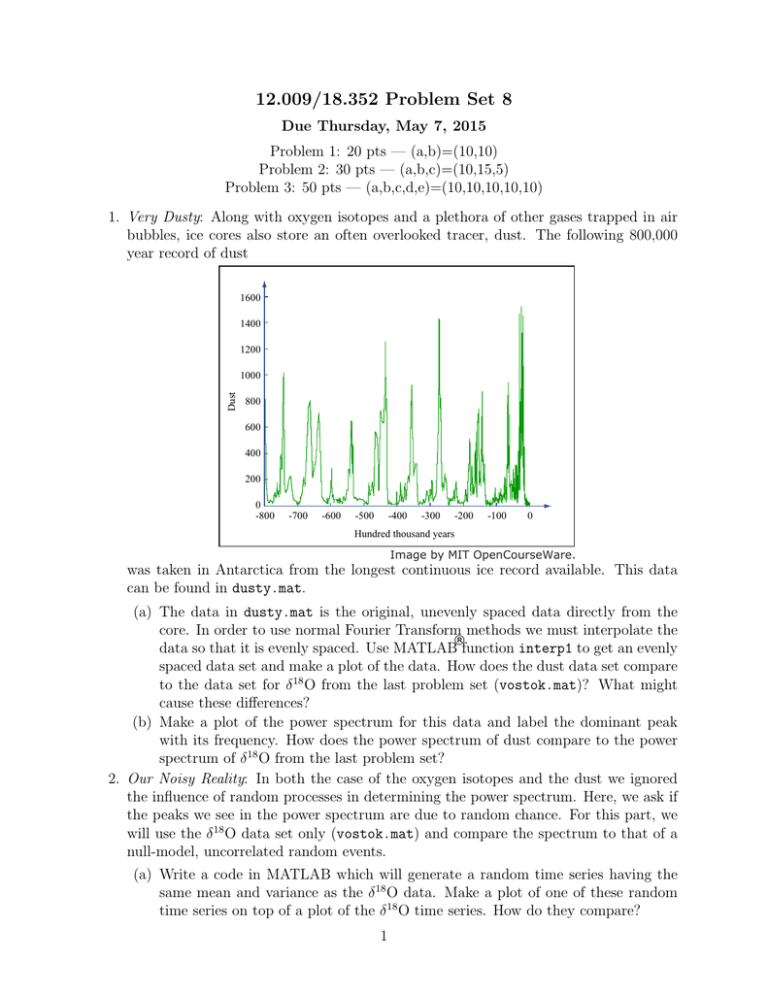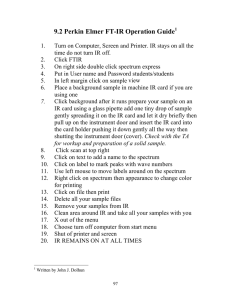
12.009/18.352 Problem Set 8
Due Thursday, May 7, 2015
Problem 1: 20 pts — (a,b)=(10,10)
Problem 2: 30 pts — (a,b,c)=(10,15,5)
Problem 3: 50 pts — (a,b,c,d,e)=(10,10,10,10,10)
1. Very Dusty: Along with oxygen isotopes and a plethora of other gases trapped in air
bubbles, ice cores also store an often overlooked tracer, dust. The following 800,000
year record of dust
1600
1400
1200
Dust
1000
800
600
400
200
0
-800
-700
-600
-500
-400
-300
-200
-100
0
Hundred thousand years
Image by MIT OpenCourseWare.
was taken in Antarctica from the longest continuous ice record available. This data
can be found in dusty.mat.
(a) The data in dusty.mat is the original, unevenly spaced data directly from the
core. In order to use normal Fourier Transform methods we must interpolate the
data so that it is evenly spaced. Use MATLAB function interp1 to get an evenly
spaced data set and make a plot of the data. How does the dust data set compare
to the data set for δ 18 O from the last problem set (vostok.mat)? What might
cause these differences?
(b) Make a plot of the power spectrum for this data and label the dominant peak
with its frequency. How does the power spectrum of dust compare to the power
spectrum of δ 18 O from the last problem set?
2. Our Noisy Reality: In both the case of the oxygen isotopes and the dust we ignored
the influence of random processes in determining the power spectrum. Here, we ask if
the peaks we see in the power spectrum are due to random chance. For this part, we
will use the δ 18 O data set only (vostok.mat) and compare the spectrum to that of a
null-model, uncorrelated random events.
(a) Write a code in MATLAB which will generate a random time series having the
same mean and variance as the δ 18 O data. Make a plot of one of these random
time series on top of a plot of the δ 18 O time series. How do they compare?
1
(b) We are interested in understanding which peaks in the power spectrum of δ 18 O are
significantly different than what we could expect to be generated from a random,
uncorrelated time series. Write a MATLAB script which generates many random
time series and their power spectra. On your plot of the power-spectrum for δ 18 O
plot a boundary curve for which 95% of the random spectra did not pass. We will
refer to this as a ‘noise floor’. What does it mean for a peak to be greater than
this?
(c) Which frequencies in the power spectrum are both consistent with orbital forcing
and above the ‘noise floor’ for the random null model?
3. Modern Climate Change: In a previous problem set, we looked at modern climate time
series and thought about what caused the oscillations and phase shifts between the
climate records in Point Barrow, Mauna Loa, and the South Pole.
© sources unknown. All rights reserved. This content is excluded from our Creative
Commons license.For more information, see http://ocw.mit.edu/help/faq-fair-use/.
For the analysis in this problem use the time-series for carbon dioxide at the Mauna
Loa station. See problem set 3 for information on accessing the data.
(a) Make a plot of the power spectrum for the entire record and label the peak. Where
is the spectral peak and what is its physical interpretation?
(b) Looking at the power spectrum more closely, what do you think the power spectrum of the noise is in this system?
(c) Repeat the above pair of calculations using the first 5, 10, 15, 20, 25 and 30 years
of the record. How does the height of the ‘noise floor’ and spectral peak scale
with the length of the time series?
(d) Show that this is consistent with the calculations done in class. Assuming Gaussian white noise, what is the probability that the dominant peak in the record
appeared there by random chance?
(e) Use the fft and ifft commands in MATLAB, along with some coding of your
own, to remove the dominant periodic signal from the data. What part of the
signal remains? How might these ideas be very useful for analyzing more complicated data sets? Verify that the imaginary part of the inverse fourier transform
is within numerical noise. Include a plot of both the real and imaginary parts of
the inverse transform in your answer.
2
MIT OpenCourseWare
http://ocw.mit.edu
12.009J / 18.352J Theoretical Environmental Analysis
Spring 2015
For information about citing these materials or our Terms of Use, visit: http://ocw.mit.edu/terms.




